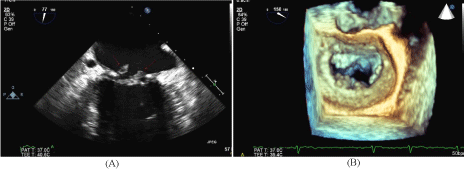Clinical Image
Dry Pars Plana Vitrectomy for Aqueous Misdirection During Cataract Surgery
Yusen Huang*
Qingdao Eye Hospital, Shandong Eye Institute, Shandong Academy of Medical Sciences, China
*Corresponding author: Yusen Huang, Shandong Eye Institute, 5 Yanerdao Road, Qingdao 266071, P. R. China
Published: 15 Jun, 2017
Cite this article as: Huang Y. Dry Pars Plana Vitrectomy for
Aqueous Misdirection During Cataract
Surgery. Ann Clin Case Rep. 2017; 2:
1378.
Clinical Image
Aqueous misdirection following uneventful phacoemulsification is rare. Herein I report such
a case during cataract surgery, which was treated successfully by 25-gauge pars plana vitrectomy.
A 79-year-old man had bilateral age-related immature-stage cataract with open angles and
no history of glaucoma. The corneal curvature was 44.70/45.30. The axial length, measured by
intraocular lens (IOL) Master, was 23.08 mm. B-scan ultrasound demonstrated liquefied vitreous. A
clear corneal incision phacoemulsification was performed uneventfully with placement of a foldable
IOL in the capsular bag. After the viscoelastic material was removed from the bag and anterior
chamber, the anterior chamber became shallow. Balanced Salt Solution (BSS) was injected into the
anterior chamber to deepen it, and the corneal incision was closed by stromal hydration. However,
the anterior chamber was still flat, the iris prolapsed from the corneal incision, and the eye globe was
very solid as tested by fingers.
It was thought that aqueous flow was diverted posteriorly into the vitreous cavity, resulting
in aqueous misdirection. A core pars plana vitrectomy was performed without infusion using a
25-gauge sutureless vitrectomy system. The forward pressure was reduced, and the eye was softened,
before the anterior chamber was re-formed by injecting BSS through the corneal incision (Figure 1).
After a communication between the vitreous cavity and anterior chamber was created, the anterior
chamber got re-formed spontaneously and remained deep. The corneal incision and sclerotomy
site were closed with no sutures. Postoperatively, the visual acuity was 20/25, and the intraocular
pressure was 19 mmHg without anti-glaucoma medications.
Aqueous misdirection, formerly referred to as malignant glaucoma, is characterized by elevated
intraocular pressure and a shallow or flat anterior chamber without pupillary block or choroidal
abnormalities [1]. It occurs not only in small eyes with anatomically narrow anterior chamber angles [2], usually after glaucoma surgery, laser iridotomy or miotic therapy, but also in eyes treated by capsulotomy or vitrectomy [3] and pseudophakic eyes [4]. To our knowledge, this is the first case
occurring during cataract surgery.
The exact pathophysiologic mechanism of aqueous misdirection
has not been fully explained. It may be the misdirection of aqueous
into or behind the vitreous body because of an abnormal anatomic
relationship between the ciliary processes, crystalline or IOL,
and anterior vitreous face [1,5]. However, since pseudophakic
malignant glaucoma occasionally occurs in eyes with no narrow
anterior chamber angles or angle-closure glaucoma, an alternative
mechanism needs to be proposed for causation. In this case, aqueous
misdirection occurred after IOL implantation and irrigation, and was
aggravated after BSS injection. The notably liquefied vitreous may
allow the irrigated fluid to flow posteriorly through the zonule during
phacoemulsification and irrigation, lead to increased resistance
through the anterior vitreous, displace the iris-lens diaphragm and
ciliary body forward, and result in acute glaucoma. The liquefied
vitreous was speculated to play a role in the initiation of the aqueous
misdirection in this eye.
The goal of treatment for aqueous misdirection is to re-establish
normal aqueous flow by creating a free communication between
the posterior and anterior segments. It is initially treated with
cycloplegics, aqueous suppressants, and hyperosmotics. For cases
refractory to medication, combined pars plana vitrectomy, hyaloidozonulectomy,
and peripheral iridectomy is needed. How to deal with malignant glaucoma occurring during cataract surgery has not been reported. In this case, a core vitrectomy was employed using the 25-gauge vitrectomy system without infusion, and the anterior
vitreous gel which obstructed fluid flow during cataract surgery
for sudden pseudophakic malignant glaucoma was removed. This
approach seems simple and safe to be performed by cataract surgeons.
Figure 1
Figure 1
B-scan ultrasound images before surgery and intraoperative video screenshots. (A) Obvious liquefied
vitreous. (B) The flat anterior chamber, asymmetrical intraocular lens, and iris prolapse from the corneal incision.
(C) A core 25-gauge pars plana vitrectomy without infusion. (D) The reformed anterior chamber.
References
- Luntz MH, Rosenblatt M. Malignant glaucoma. Surv Ophthalmol. 1987; 32: 73-93.
- Sharma A, Sii F, Shah P, Kirkby GR. Vitrectomy-phacoemulsification-vitrectomy for the management of aqueous misdirection syndromes in phakic eyes. Ophthalmology. 2006; 113: 1968-1973.
- Bitrian E, Caprioli J. Pars plana anterior vitrectomy, hyaloido-zonulectomy, and iridectomy for aqueous humor misdirection. Am J Ophthalmol. 2010; 150: 82-87.
- Koukkoulli A, Rahman R. An unusual presentation of aqueous misdirection. Eye (Lond). 2013; 27: 675-676.
- Epstein DL, Hashimoto JM, Anderson PJ, Grant WM. Experimental perfusions through the anterior and vitreous chambers with possible relationships to malignant glaucoma. Am J Ophthalmol. 1979; 88: 1078-1086.

